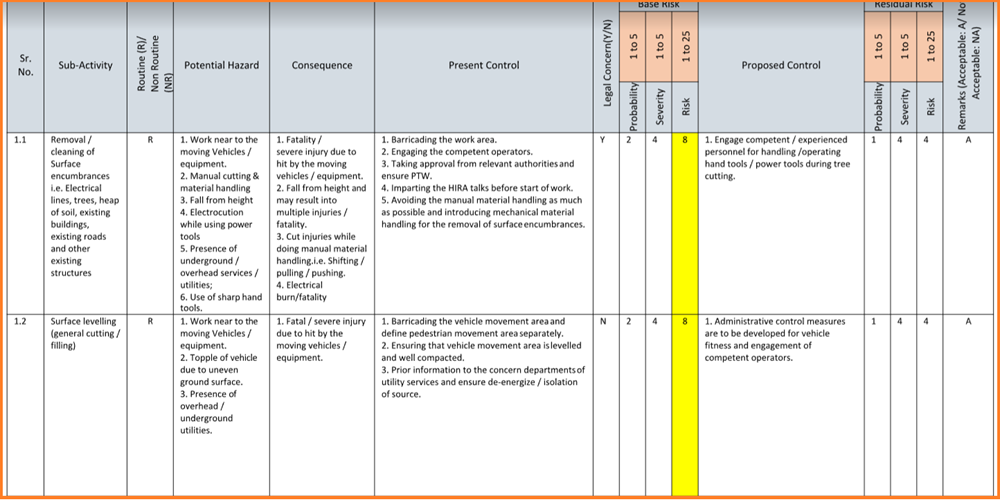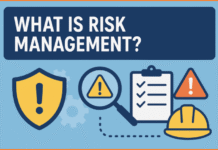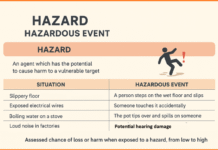In the field of industrial safety, two important methodologies play a fundamental role in ensuring the safety of workers and the integrity of operations: Job Safety Analysis (JSA) and Risk Assessment. Both are designed to identify and mitigate potential hazards; they differ in their approaches and applications. This blog post aims to shed light on the distinctions between JSA and Risk Assessment, highlighting their unique characteristics and emphasizing the importance of incorporating both into a comprehensive safety management system.
Job Safety Analysis (JSA):
Job Safety Analysis, also known as Job Hazard Analysis (JHA), is a systematic process used to identify, assess, and mitigate potential hazards associated with specific job tasks. It is a proactive approach that involves breaking down a job into its individual steps, identifying potential hazards at each step, and determining appropriate preventive measures. JSA is often task-oriented and focuses on the immediate work environment.

Key features of JSA include:
- Task-Centric Approach: JSA is centered around specific job tasks, making it a valuable tool for understanding the inherent risks associated with each task.
- Worker Involvement: Workers actively participate in the JSA process, providing firsthand knowledge of the job tasks and contributing to the identification of potential hazards.
- Real-time Application: JSA is often conducted before a task is performed, allowing for the identification and correction of potential hazards before they pose a threat to workers.
Risk Assessment:
Risk assessment is a broader and more detailed process that evaluates potential risks and their consequences across an entire operation or system. It involves the systematic identification of hazards, the analysis of their likelihood and severity, and the determination of appropriate risk control measures. Unlike JSA, which is task-specific, risk assessment looks at the bigger picture, considering the overall risks associated with an entire process or facility.

Key features of Risk Assessment include:
- Holistic Perspective: Risk assessment considers all potential hazards within a system or process, providing a detailed overview of the risks associated with an entire operation.
- Quantitative Analysis: Risk assessment often involves assigning numerical values to the likelihood and severity of identified risks, allowing for a more quantitative analysis of the overall risk profile.
- Long-term Planning: While JSA is focused on immediate tasks, risk assessment is geared towards long-term planning and decision-making, helping organizations prioritize resources for maximum risk reduction.
Integration for Comprehensive Safety:
While JSA and Risk Assessment have distinct purposes and scopes, they are not mutually exclusive. In fact, the most effective safety management systems incorporate both methodologies to create a robust framework for risk identification and mitigation.
- Sequential Application: Organizations can start with JSA to identify and address immediate task-related hazards and then use the findings as input for a broader risk assessment that considers the cumulative impact of various tasks on the overall safety of the workplace.
- Continuous Improvement: Safety is an evolving aspect of industrial operations. Regularly updating and revisiting both JSA and Risk Assessment processes ensures that safety measures remain effective and aligned with changing work environments and processes.
In the complex field of industrial safety, understanding the nuances between Job Safety Analysis and Risk Assessment is essential. While JSA focuses on task-specific hazards, Risk Assessment provides a broader perspective on the overall risks associated with an operation. Integrating both methodologies into a comprehensive safety management system enhances an organization’s ability to create a safer working environment, protect its workforce, and ensure the longevity and success of its operations.
In short – JSA (Job Safety Analysis) and HIRA (Hazard Identification and Risk Assessment) are both important tools used in occupational safety to identify and mitigate risks in the workplace. While they share similarities, they serve different purposes and have distinct characteristics.
- Purpose:
- JSA (Job Safety Analysis): Focuses on the specific tasks or jobs performed in the workplace. It aims to identify potential hazards associated with each task and develop control measures to mitigate the risks.
- HIRA (Hazard Identification and Risk Assessment): Takes a broader approach by assessing hazards and risks across the entire workplace, including processes, equipment, and environmental factors.
- Scope:
- JSA: Typically applied at the task or job level. It involves breaking down a job into specific steps, identifying potential hazards at each step, and determining ways to eliminate or control those hazards.
- HIRA: Encompasses a more comprehensive evaluation that considers various aspects of the workplace, including organizational systems, processes, and activities. It involves identifying and assessing hazards and risks on a broader scale.
- Level of Detail:
- JSA: Involves a detailed analysis of specific tasks or jobs, focusing on the sequence of steps and associated hazards. It is often used for routine or repetitive tasks.
- HIRA: Provides a higher-level overview, considering a wider range of potential hazards and risks within the workplace. It may be applied to complex processes or entire work environments.
- Application:
- JSA: Commonly used for specific tasks or jobs, especially those with a higher risk of accidents or injuries. It is often conducted at the operational level.
- HIRA: Applicable at the strategic level to identify and assess risks across the organization. It helps in developing a comprehensive risk management plan.
- Integration:
- JSA: Can be integrated into the broader risk management process, but its primary focus is on the analysis of specific job tasks.
- HIRA: Integral to the overall risk management process, considering risks at a higher level and helping in the prioritization of risk mitigation strategies.
In practice, organizations often use a combination of JSA and HIRA to ensure a thorough and systematic approach to safety. JSA may be applied to individual tasks, while HIRA provides a holistic view of risks within the organization. Both tools contribute to creating a safer work environment by identifying and mitigating potential hazards and risks.
Frequently asked questions about the difference between Hazard Identification and Risk Assessment (HIRA) and Job Safety Analysis (JSA):
Q: What is the main difference between HIRA and JSA?
A: HIRA and JSA differ in their scope and focus. HIRA takes a broader approach by assessing hazards and risks across the entire workplace, including processes, equipment, and environmental factors. On the other hand, JSA focuses on the specific tasks or jobs performed in the workplace and aims to identify potential hazards associated with each task.
Q: How do HIRA and JSA differ in terms of purpose?
A: JSA focuses on understanding and addressing the hazards associated with specific job tasks, aiming to develop control measures to mitigate the risks. HIRA, on the other hand, takes a more comprehensive approach and assesses hazards and risks across the organization, helping in the development of a comprehensive risk management plan.
Q: Are HIRA and JSA applied at different levels in an organization?
A: Yes, HIRA and JSA are often applied at different levels in an organization. JSA is commonly used at the operational level for specific tasks or jobs, especially those with a higher risk of accidents or injuries. HIRA, on the other hand, is applicable at the strategic level, helping to identify and assess risks across the organization and develop a comprehensive risk management plan.
Q: How detailed is the analysis in HIRA compared to JSA?
A: JSA involves a detailed analysis of specific tasks or jobs, focusing on the sequence of steps and associated hazards. It is often used for routine or repetitive tasks. On the other hand, HIRA provides a higher-level overview, considering a wider range of potential hazards and risks within the workplace. It may be applied to complex processes or entire work environments.
Q: Can HIRA and JSA be integrated into a comprehensive safety management system?
A: Absolutely! HIRA and JSA are not mutually exclusive and can be integrated into a comprehensive safety management system. Organizations can start with JSA to identify and address immediate task-related hazards and then use the findings as input for a broader risk assessment like HIRA, which considers the cumulative impact of various tasks on the overall safety of the workplace.
These are some of the key differences between HIRA and JSA. Utilizing both methodologies can help organizations enhance their safety management systems by thoroughly identifying and mitigating potential hazards and risks in the workplace.





